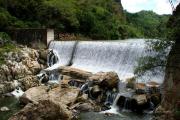The Battle of Zapote River, also known as the Battle of Zapote Bridge, happened on June 13, 1899 between 3,000 Americans and 5,000 Filipinos. It was the second largest battle of the Philippine-American War. Zapote River separates what is now the city of Las Piñas in Metro Manila from Bacoor, Cavite. The ruins of Zapote Bridge still stand along the General Emilio Aguinaldo Highway near Manila Bay.
The Zapote Bridge is also part of the restoration project, as it will serve as a reminder of the courage and valor of Filipino revolutionaries, led by General Edilberto Evangelista, during the bloody battle for freedom.
The Battle
The battle started when Companies F and I, 21st Infantry Regiment were confronted by 1,000 Filipinos in elaborately dug trenches and breastworks, and fierce fighting ensued, but the Americans running low on ammunition had to break through the enemy's flank. American gunboats, including USS Helena, also silenced a Philippine artillery piece which had been harassing them.
An artillery duel also commenced between a Filipino artillery battery, possibly firing a Krupp artillery piece, and Battery D with a 3.2-inch field gun. After a few closely exchanged shots, Battery D successfully took out the enemy battery at 30 yards, while losing two men.
The rest of both armies soon joined the fighting, and it became obvious that the superior Filipino numbers had not been a decisive advantage. Accurate American rifle and machine gun fire inflicted terrible losses on the enemy, while the Filipinos, many armed with motley firearms or bolos, did not have the firepower to successfully retaliate on most occasions. American gunboats also devastated the Filipino positions.
After hours of heavy fighting, the superior firepower of the Americans drove the defenders out of their lines; a Filipino rear guard, however held off the Americans long enough for the main Filipino force to withdraw inland.










